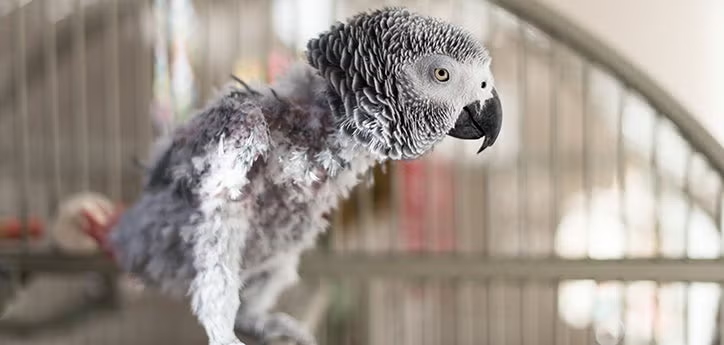Feather picking. It’s one of the most frustrating—and heartbreaking—problems bird owners face. Watching a once-beautiful, vibrant bird pluck out its own feathers can leave you feeling helpless, confused, and desperate for answers.
But here’s the good news: feather picking is often a symptom, not a life sentence. By understanding what’s behind the behavior—whether it’s medical, emotional, or environmental—you can take meaningful steps to help your bird heal.
In this article, we’ll explore the common causes of feather picking, other behavioral issues that may come along with it, and how you can create a healthier, happier environment for your feathered friend.
What Is Feather Picking?
Feather picking, or feather plucking, is when a bird intentionally pulls out its own feathers. This isn’t the same as normal preening, where birds clean and straighten their feathers. In feather picking, the bird may remove feathers from specific areas (like the chest, wings, or legs), or in extreme cases, cause wounds or bleeding.
Feather picking is a behavior, not a diagnosis. It’s a visible sign that something’s wrong—either physically, emotionally, or both.
Common Causes of Feather Picking
1. Medical Issues
Always rule out health problems first. In many cases, feather picking is the bird’s way of responding to pain, discomfort, or irritation.
Possible medical causes include:
- Skin infections (bacterial, fungal, or parasitic)
- Allergies (to food, dust, or chemicals)
- Nutritional deficiencies (especially Vitamin A)
- Liver disease or hormonal imbalances
- Toxic exposure (heavy metals, fumes, etc.)
- Pain from old injuries or internal illness
Solution:
The very first step if your bird starts plucking is to visit an avian veterinarian. A full checkup—including bloodwork and feather analysis—can uncover hidden health issues. No amount of environmental enrichment will help if the underlying problem is physical.
2. Boredom and Lack of Enrichment
Birds are intelligent, active creatures. In the wild, they spend hours foraging, flying, and socializing. When kept in a cage with little stimulation, they can develop compulsive behaviors like feather picking.
Warning signs:
- Repetitive pacing or swinging
- Screaming or loud vocalizations
- Over-preening or plucking during the day
- Aggression or sudden mood changes
Solution:
- Provide a variety of toys (especially foraging and puzzle toys)
- Change the layout of the cage every week or two
- Offer daily out-of-cage time
- Train simple tricks to stimulate their mind
- Rotate new perches and textures to explore
Enrichment isn’t just “nice to have”—it’s essential for their mental health.
3. Stress and Anxiety
Birds are sensitive to changes in their environment and routines. A stressed bird may begin picking to self-soothe.
Common stressors:
- A move to a new home
- Loss of a companion (human or another bird)
- Loud noises or sudden changes in lighting
- Lack of sleep or irregular day-night cycles
- Being left alone for long periods
Solution:
- Keep a consistent routine
- Provide 10–12 hours of dark, uninterrupted sleep
- Avoid sudden loud sounds or overstimulation
- Use a white noise machine or calming music
- Consider placing the cage in a quieter room, away from chaos
In some severe cases, a bird may benefit from temporary use of anti-anxiety medications, but this should only be done under veterinary supervision.
4. Hormonal Behavior
Feather picking often spikes during breeding season. Hormonal birds may become territorial, aggressive, or overly attached to one person. They may start picking in areas associated with mating, such as the chest or thighs.
Triggers include:
- Too much daylight (more than 12 hours)
- Access to nesting materials or dark corners
- Overhandling or petting along the back or under wings
Solution:
- Limit daylight to 10–12 hours per day
- Remove nest-like spaces and soft bedding
- Avoid “sexual” petting—stick to head and neck
- Minimize hormonal triggers and vet-check hormone levels if needed
5. Habitual or Learned Behavior
If a bird has been picking for a long time—especially if it started during a stressful event—it can become a deeply ingrained habit. Even after medical and environmental issues are corrected, the behavior might persist.
Solution:
- Redirect the habit with enrichment and positive reinforcement
- Use “busy toys” to keep the beak and mind occupied
- Sometimes, bird-safe collars (used temporarily) can prevent further injury while healing
- Work with a certified avian behaviorist if needed
Consistency and patience are key—reversing ingrained behavior takes time.
Other Related Behavioral Issues
Feather picking often coexists with other behavioral problems, such as:
- Screaming or excessive vocalization
- Aggression toward people or other birds
- Self-mutilation (biting skin, drawing blood)
- Destructive chewing on cage bars or furniture
Each of these behaviors has its own root causes and solutions, but they often stem from the same issues: stress, lack of stimulation, hormonal changes, or unmet social needs.
When to Seek Help
It’s never too early to get help. If your bird:
- Starts plucking suddenly
- Creates bald spots or bleeding wounds
- Shows behavior changes (aggression, withdrawal, screaming)
- Seems restless or lethargic
- Has not improved after environmental adjustments
…then it’s time to consult a qualified avian vet. You may also benefit from working with a certified avian behavior consultant, who can help assess the bird’s environment, routine, and stress triggers.
There Is Hope
Feather picking isn’t easy to fix—but it’s not hopeless. With patience, knowledge, and the right support, many birds recover beautifully. The key is understanding that feather picking is a symptom, not the problem itself. Once you get to the root of it—whether it’s medical, mental, or emotional—you can take steps toward healing.
Birds don’t pluck out of spite. They’re trying to tell us something. And if we’re willing to listen, they’ll often show us exactly what they need.

